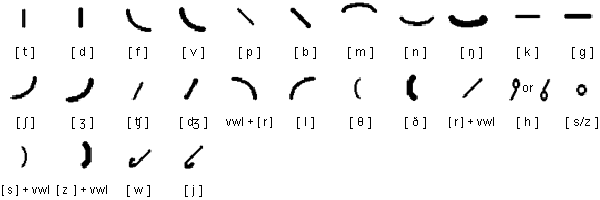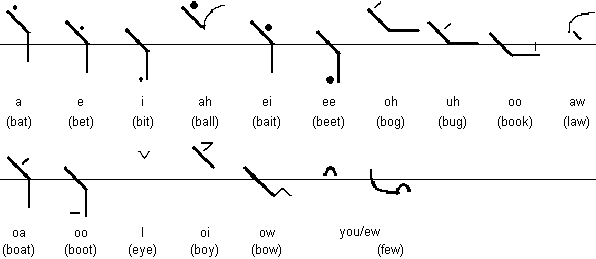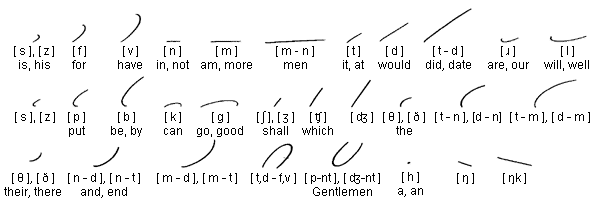A brief history of shorthand systems
Ever since the invention of writing scribes have used various techniques to enable them to take notes quickly and efficiently.The Ancient Egyptians devised two scripts, Hieratic and Demotic, as alternatives to their complex Hieroglyphic script, which was used mainly for monumental inscriptions. Both Hieratic and Demotic worked on the same principles as the Hieroglyphs but the symbols were considerably simplified.
During the 4th century BC, the Greeks devised a number of symbol systems which reduced letters to a single stroke and which could also be used to represent common words, suffixes and prefixes. Such systems are generally referred to as stenography (narrow writing), brachygraphy (short writing) or tachygraphy (swift writing). Their purpose was to make writing more compact and/or faster.
One shorthand system popular with the Romans was Tironian Notes or Notae Tironianae, which was invented by Cicero's secretary Tiro in order to record Cicero's speeches. It used a combination of simplified letters and special symbols and was used in Europe in various forms until the Middle Ages.
During the Han Dynasty (207BC - 220AD) the Chinese devised two methods of rapid writing known as xíngshū (running script) and căoshū (draft script). In the Running script some of the strokes that make up characters are joined and others are left out. In the Draft script each character is written with a single continuous stroke and there is considerable variation in how this is done. As a result, the Draft script is very difficult to read without special training. Attempts have been made to standardise the way the characters are written in the Draft script but they have not met with popular acclaim.
Modern shorthand systems
There are many different shorthand systems currently in use. The most popular ones include:Pitman Shorthand
Pitman Shorthand was devised by Sir Isaac Pitman (1813-1897) and was first published in 1837. Over the years is has been gradually improved and has been also adapted for 15 different languages. The system was widely used in the UK and USA by secretaries, reporters and writers, but lost popularity with the invention of pocket tape recorders.Notable features
- Pitman is phonetic: it records the sounds of speech rather than the spelling. For example, the sound [f] in form, elephant and rough is written in the same way for each word.
- Vowel sounds are optional and are written with small dots, dashes or other shapes next to the main strokes. This helps increase writing speed because most words can be identified from their consonants only.
- The thickness, length and position of the strokes are all significant.
- There are many special abbreviations and other tricks to increase writing speed.
- The record for fast writing with Pitman shorthand is 350 wpm during a two-minute test by Nathan Behrin in 1922.
Pitman consonants

Pitman vowels

Pitman abbreviations

Sample text in Pitman

'Translation'
All human beings are born free and equal in dignity and rights. They are endowed with reason and conscience and should act towards one another in a spirit of brotherhood.(Article 1 of the Universal Declaration of Human Rights)
Tower of Babel in Pitman Shorthand
Gregg Shorthand
Gregg was invented by John Robert Gregg (1867-1948) and was first published in 1888. Since then many different versions have appeared, including some for languages other than English. Gregg is still used, particularly in the USA.Notable features
- Gregg is phonetic: it records the sounds of speech rather than the spelling. For example, the sound [f] in form, elephant and rough is written in the same way for each word.
- Vowels are written as hooks and circles on the consonants.
Gregg consonants

Gregg vowels

Gregg punctuation

Gregg sample text

'Translation'
All human beings are born free and equal in dignity and rights. They are endowed with reason and conscience and should act towards one another in a spirit of brotherhood.(Article 1 of the Universal Declaration of Human Rights)
Gregg illustrations provided by Andrew Owen.
Tower of Babel in Gregg Shorthand
Links
Informationa about Shorthandhttp://en.wikipedia.org/wiki/Shorthand
http://www.beyondtheofficedoor.com/articles-learning-shorthand-for-the-office.html
http://www.alysion.org/handy/althandwriting.htm
http://shorthandshorthandshorthand.com
http://www.youtube.com/watch?v=H7zLAhN_UU4
The Joy of Pitman Shorthand
http://pitmanshorthand.homestead.com
Gregg Shorthand - a Web Site dedicated to the perpetuation of pen stenography
http://gregg.angelfishy.net
Gregg Shorthand Group
http://greggshorthand.multiply.com
Teeline shorthand - an introduction
http://www.ma-radio.gold.ac.uk/shorthand/teeline1.htm
Groote shorthand - a Dutch shorthand system designed for take notes while on horseback
http://www.waij.com/shorthand/
Deutschen Einheitskurzschrift (German Unified Shorthand)
http://de.wikipedia.org/wiki/Deutsche_Einheitskurzschrift
Shorthand converter - converts text into Deutschen Einheitskurzschrift, Pitman or Gregg Shorthand: http://home.tu-clausthal.de/~rzsjs/steno/Gregg.php
Shorthand forum - will include lessons and discussion about shorthand
http://www.shorthand-untangled.co.uk
Shorthand training materials
http://www.tbtrainingmaterials.co.uk
Digital library of shorthand materials
http://cdm16471.contentdm.oclc.org/cdm/landingpage/collection/p15457coll1/preview/1
Keyscript Shorthand
http://www.freewebs.com/cassyjanek/









.jpg)
.jpg)

.jpg)





0 comments:
Post a Comment
Note: Only a member of this blog may post a comment.